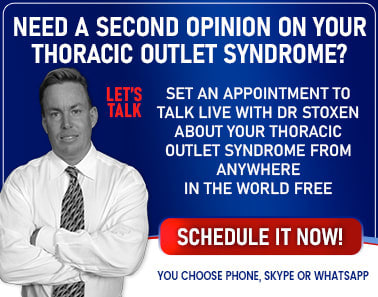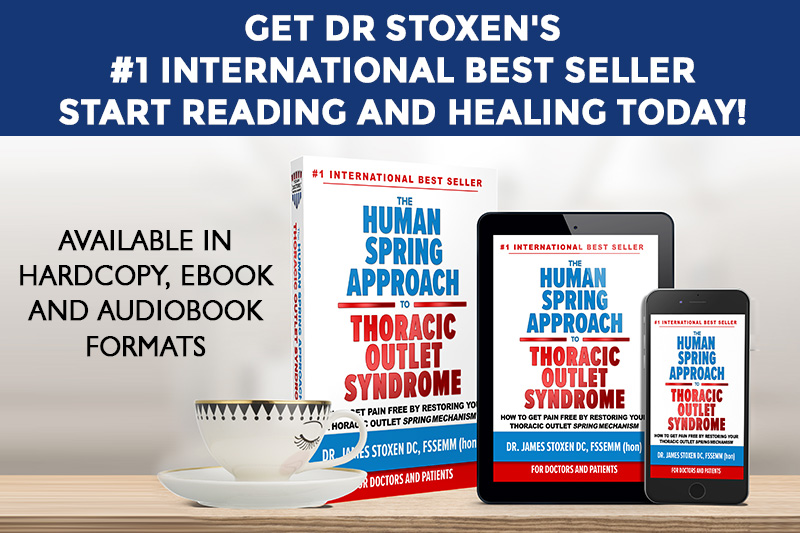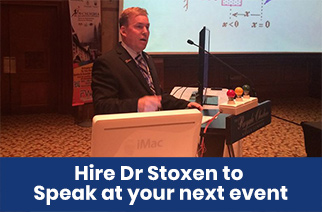When you reach your arm and hand outside perpendicular for longer than a few minutes, you are engaging a sustained contraction of muscles that depress and compress the shoulder down into the thoracic outlet and tunnel.
When you reach out your arm to manipulate an object in front of you, a series of muscle contractions occur that can cause a narrowing of the costoclavicular space and the subpectoral space.
- The lower trapezius and latissimus dorsi contract to pull the shoulder girdle down to stabilize and anchor the shoulder to the chest to provide a solid platform to counterbalance the weight of the shoulder and arm in front of the body.
- The pectoralis minor muscles, the coracobrachialis, and the biceps short head anchor the shoulder blade down to the chest to maintain a solid platform for the arm flexion.
- The subclavius muscle stabilizes the collarbone to the first rib and in the process, it lifts the first rib into the outlet and pulls the collarbone down into the thoracic outlet.
The longer you hold your shoulder arm and hand in this position . . .
- The longer the muscles contract.
- The longer the muscles contract, the more they will spasm.
- The more they spasm, the more deeply the reflex will be burned into the brain.
- The deeper the reflex is burned into the brain, the longer it will take to reprogram.
- The longer it takes to reprogram, the more unlikely you will have a successful physical therapy experience.
- The more physical therapy sessions that fail you, the more likely you will either live with long-term suffering or TOS surgery you never needed.
Ma’am, please remove your hand from the smartphone, mouse, keyboard) and nobody gets hurt.

Sustained Contraction of the Muscle Attaching to the Coracoid Process
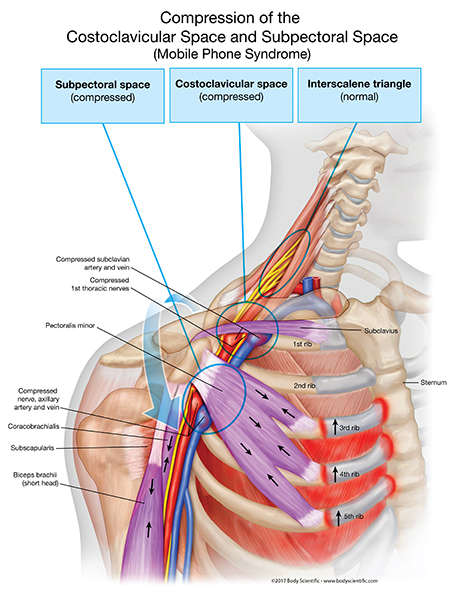
There are other muscles, when in an abnormally contracted state or constantly contracted, that can contribute to the narrowing of the subclavian space. The pectoralis minor muscle, biceps short head muscle, the coracobrachialis, and the anterior (front) neck muscles of the shoulder can contribute to the compression of the collarbone into the thoracic tunnel.
These muscles are always contracted in a super contracted state, because they all contract together when lifting the arm to the front of the body.
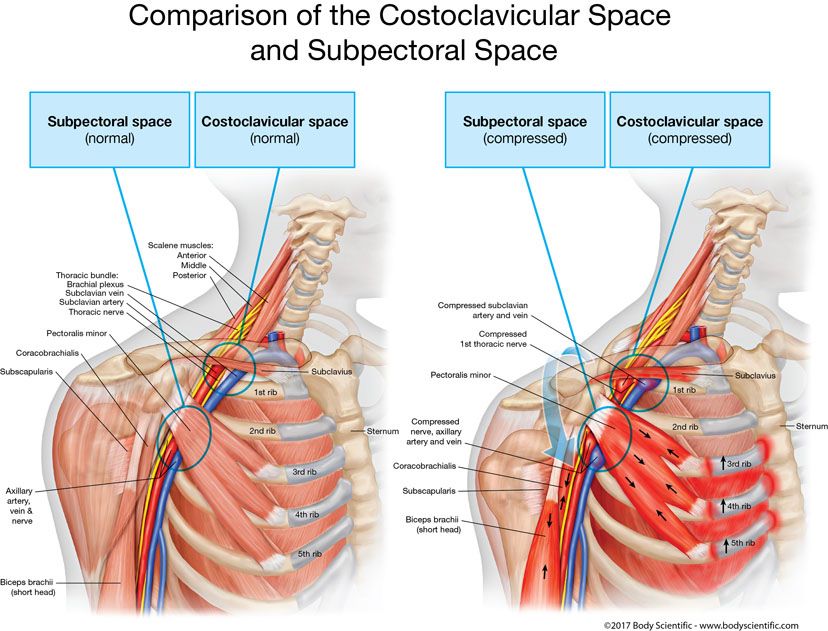
Costoclavicular Space Compression and Thoracic Cortical Pectoralis Space
Narrowing of the thoracic cortical pectoralis space can result from shortening of the pectoralis minor muscle (30). This hypercontracted pectoralis minor muscle, the subclavius muscle, the coracobrachialis muscle, and the biceps short head muscle can act together to compress the area. The swollen, hypercontracted pectoralis minor muscle by itself can compress the artery, vein, and nerves as they pass beneath it.
We all know a large proportion of Americans are addicted to their cell phones and other handheld devices. But there are considerable risk factors and clinical features of the musculoskeletal disorders due to the use of these devices. This includes not only mobile phones, but handheld devices, such as game controls, tablets, iPods, iPads, and other portable electronic items.
Put your hand on the opposite side of your chest just below your collarbone. Now lift the arm on that side to place your hand at the level of your eyes, as if you were looking at your cell phone. You should feel a muscle contraction under your hand on your chest. This is the pectoralis minor muscle.
These muscles contract to lock the shoulder to the chest wall to provide a stable platform to allow you to extend your 10-pound arm out away from the human spring. The farther away, the more pressure it exerts at the fulcrum base. Your brain thinks this constant, extended contraction of these muscles is you contracting them for a long time on purpose.
It also shifts or locks ribs three, four, and five and the ribs they connect to, which can lead to pain between the shoulder blades, where these ribs connect to the spine, and chest pain, where the ribs connect to the sternum or breastbone.
Oftentimes, people think they are having a heart attack (difficulty getting a deep breath, shortness of breath, crushing chest pain, and mid back pain) and they rush to the hospital, only to find that their heart is normal.
If you don’t know the cause of your thoracic outlet syndrome then you wont know how to calm it down.
When doctors suspect the shoulder is being dragged down into the thoracic outlet by muscles in the arm and chest they only surgically remove the pectoralis minor.
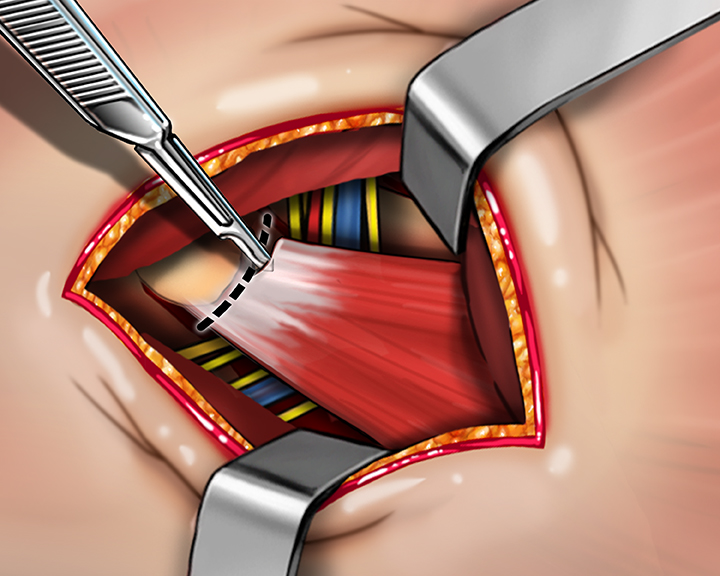
Even if you got the pectoralis minor muscle resected (cut), the shoulder would still be dragged into the thoracic outlet by the coracobrachialis muscle, biceps short head, latissimus dorsi and lower trapezius.
Do you realize you are cutting muscles and bones out of your body causing permanent damage to your structure simply because your doctors and therapists don’t have an effective approach to relaxing these spasmed muscles.
If you get a cramp in your calf or a stiff neck from a car accident, is the cure to cut those muscles out too?
Contact me for a free strategy meeting before you get surgery that you don’t need.

Dr James Stoxen DC., FSSEMM (hon) He is the president of Team Doctors®, Treatment and Training Center Chicago, one of the most recognized treatment centers in the world.
Dr Stoxen is a #1 International Bestselling Author of the book, The Human Spring Approach to Thoracic Outlet Syndrome. He has lectured at more than 20 medical conferences on his Human Spring Approach to Thoracic Outlet Syndrome and asked to publish his research on this approach to treating thoracic outlet syndrome in over 30 peer review medical journals.
He has been asked to submit his other research on the human spring approach to treatment, training and prevention in over 150 peer review medical journals. He serves as the Editor-in-Chief, Journal of Orthopedic Science and Research, Executive Editor or the Journal of Trauma and Acute Care, Chief Editor, Advances in Orthopedics and Sports Medicine Journal and editorial board for over 35 peer review medical journals.
He is a much sought-after speaker. He has given over 1000 live presentations and lectured at over 70 medical conferences to over 50,000 doctors in more than 20 countries. He has been invited to speak at over 300 medical conferences which includes invitations as the keynote speaker at over 50 medical conferences.
After his groundbreaking lecture on the Integrated Spring-Mass Model at the World Congress of Sports and Exercise Medicine he was presented with an Honorary Fellowship Award by a member of the royal family, the Sultan of Pahang, for his distinguished research and contributions to the advancement of Sports and Exercise Medicine on an International level. He was inducted into the National Fitness Hall of Fame in 2008 and the Personal Trainers Hall of Fame in 2012.
Dr Stoxen has a big reputation in the entertainment industry working as a doctor for over 150 tours of elite entertainers, caring for over 1000 top celebrity entertainers and their handlers. Anthony Field or the popular children’s entertainment group, The Wiggles, wrote a book, How I Got My Wiggle Back detailing his struggles with chronic pain and clinical depression he struggled with for years. Dr Stoxen is proud to be able to assist him.
Full Bio) Dr Stoxen can be reached directly at teamdoctors@aol.com








